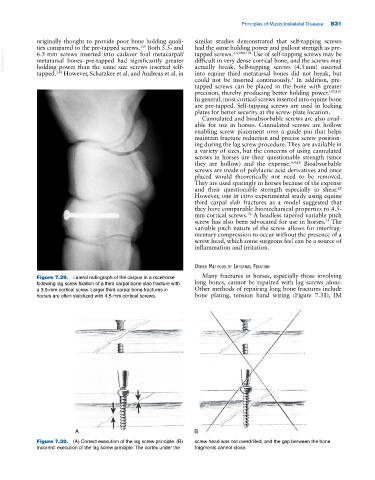Page 865 - Adams and Stashak's Lameness in Horses, 7th Edition
P. 865
Principles of Musculoskeletal Disease 831
originally thought to provide poor bone holding quali similar studies demonstrated that self‐tapping screws
119
ties compared to the pre‐tapped screws. Both 5.5‐ and had the same holding power and pullout strength as pre‐
VetBooks.ir metatarsal bones pre‐tapped had significantly greater difficult in very dense cortical bone, and the screws may
Use of self‐tapping screws may be
6.5‐mm screws inserted into cadaver foal metacarpal/
tapped screws.
2,4,100,101
holding power than the same size screws inserted self‐
actually break. Self‐tapping screws (4.5 mm) inserted
tapped. However, Schatzker et al. and Andreas et al. in into equine third metatarsal bones did not break, but
134
could not be inserted continuously. In addition, pre‐
3
tapped screws can be placed in the bone with greater
precision, thereby producing better holding power. 100,101
In general, most cortical screws inserted into equine bone
are pre‐tapped. Self‐tapping screws are used in locking
plates for better security at the screw‐plate location.
Cannulated and bioabsorbable screws are also avail
able for use in horses. Cannulated screws are hollow
enabling screw placement over a guide pin that helps
maintain fracture reduction and precise screw position
ing during the lag screw procedure. They are available in
a variety of sizes, but the concerns of using cannulated
screws in horses are their questionable strength (since
they are hollow) and the expense. 3,4,16 Bioabsorbable
screws are made of polylactic acid derivatives and once
placed would theoretically not need to be removed.
They are used sparingly in horses because of the expense
and their questionable strength especially in shear.
28
However, one in vitro experimental study using equine
third carpal slab fractures as a model suggested that
they have comparable biomechanical properties to 4.5‐
76
mm cortical screws. A headless tapered variable pitch
screw has also been advocated for use in horses. The
14
variable pitch nature of the screw allows for interfrag
mentary compression to occur without the presence of a
screw head, which some surgeons feel can be a source of
inflammation and irritation.
other methods of Internal fIxatIon
Figure 7.29. Lateral radiograph of the carpus in a racehorse Many fractures in horses, especially those involving
following lag screw fixation of a third carpal bone slab fracture with long bones, cannot be repaired with lag screws alone.
a 3.5‐mm cortical screw. Larger third carpal bone fractures in Other methods of repairing long bone fractures include
horses are often stabilized with 4.5‐mm cortical screws. bone plating, tension band wiring (Figure 7.31), IM
A B
Figure 7.30. (A) Correct execution of the lag screw principle. (B) screw head was not overdrilled, and the gap between the bone
Incorrect execution of the lag screw principle. The cortex under the fragments cannot close.

